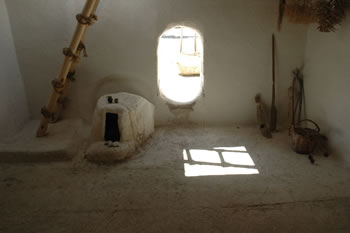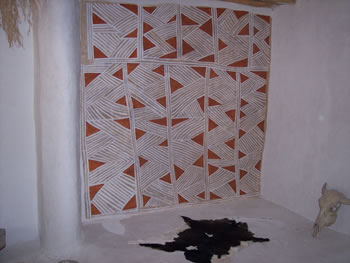EXPERIMENTAL HOUSE
Ina St George

Figure 39. A condition survey and cleaning took place in the experimental house to gain a better understanding of how to prevent damage during the off-season.
Figure 40. The experimental house was then applied with another coat of clay plaster. It was re-plastered in two hours with the participation of at least fifteen team members The plaster layer on the walls and floors consisted of the locally quarried white clay, water, and straw. The large amount of plaster sifting needed to produce material of the house was produced with the help of Ms. Russell and Ms. Hager.
Figure 41. A new painting was applied using one of the lesser known geometric designs in brown, red and white found during the excavation in 1962. |
This season, the research in the experimental house began with a condition survey and cleaning. To gain a better understanding of how to prevent damage during the off-season, it is important to note and photograph any incurred damage (Figure 39). This year, pest damage from tunneling was noted on the exterior of the north wall. Also, holes (from water leakage) in the interior floor plaster were observed under the ceiling door and along the east wall. Many insects and animals reside in the house as well. Evidence of mice, birds and a variety of insects was present.
The experimental house also received another coat of clay plaster and a new painting. The house was re-plastered in two hours with the participation of at least fifteen excavators and specialists from the site. The plaster layer on the walls and floors consisted of the locally quarried white clay, water, and straw. The large amount of plaster sifting needed to produce material of the house was produced, again, with the help of Ms. Russell and Ms. Hager (Figure 40)
The new painting is a replica of a geometric design in brown, red and white found during Mellaart’s excavation in 1962. The figurative drawings of the hunting scene and the volcano and city plan are well known. However, several of the extensively decorated houses revealed by Mellaart had repetitive, geometric designs that covered sections of walls. This year’s design was chosen to illustrate the presence of these non-figurative paintings on site (Figure 41)
Experiments were carried out to test the effectiveness of potential binders on the pigment clay layers. After researching materials which were available and utilized by the Çatalhöyük peoples, four test materials were chosen. Honey, gum Arabic, almond oil, and casein were all tested with the montmorillonite clay used on original paintings and in the experimental house. Results of this work will be published next year in the BACH group.
